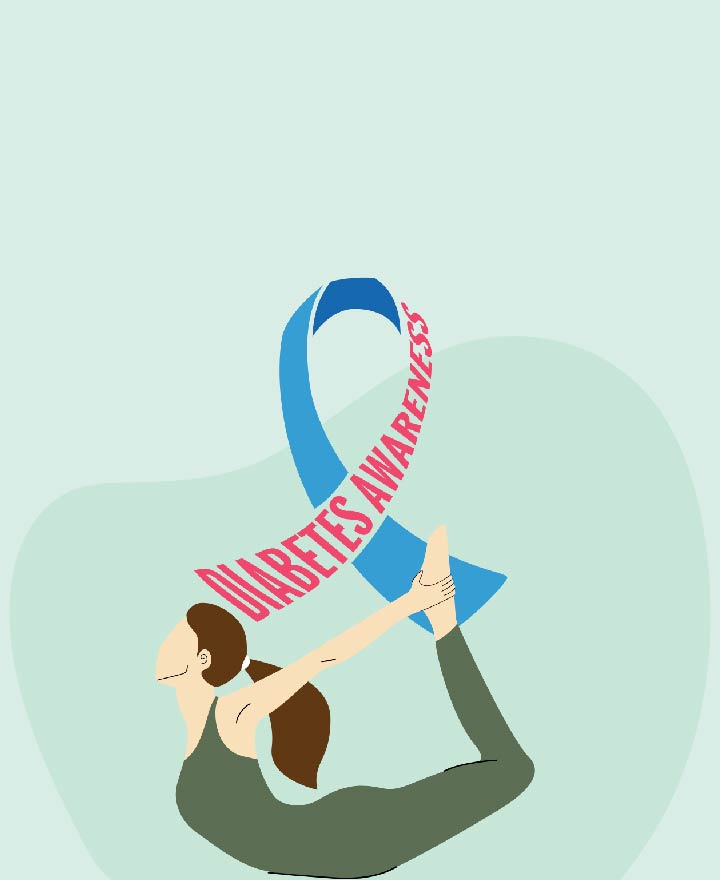

7 Effective Yoga Asanas That Will Help With Diabetes
The benefits of yoga expand beyond mental and spiritual well-being. It is also known to be effective in managing health conditions like diabetes. This article talks about connection between yoga asanas and diabetes. Read on to know more.
Yoga Poses for Diabetes
1. Surya namaskar (Sun Salutation)
This yoga asana is extremely beneficial for diabetic patients. While it is a perfect way to get your heart rate up and stretch your entire body, it also improves blood sugar level and blood circulation along with managing body’s insulin level in your body. This pose needs to be performed in the following sequence:
A. Prayer pose
B. Raised arms pose
C. Hastapadasana
D. Equestrian pose
E. Dandasana
F. Ashtanga namaskara
G. Bhujagasana
H. Adho mukha svanasana
I. Equestrian pose
J. Hastapadasana
K. Hastauttanasana
L. Mountain pose
2. Dhanurasana (Bow Pose)
Bow pose is a cure to fatigue and it is highly recommended to balance the blood sugar level. It also strengthens your abdominal muscles, reduces constipation, and helps in regulating the pancreas.
To perform this asana you need to lie flat on your stomach, fold your knees and then hold your ankles by putting your hands backwards.
3. Viparita karani (Legs Up The Wall)
To stimulate your pancreas and get your internal organs together, legs up the wall makes a significant impact on your diabetes. This asana is easy to perform and is ideal for relaxation as it boosts circulation and energy levels. It also reduces stress, controls blood pressure, and lowers blood sugar levels.
To perform this, lie flat on the floor and raise your legs against the walls at a 90° angle.
4. Shavasana (Corpse Pose)
This asana has a definite impact on lowering blood pressure, balancing blood pressure, and calming your mind and body. While you may start with any yoga asana, but you must end with a corpse pose. Moreover, it is a traditional way to finish your yoga session.
This asana is performed by lying flat on your back, keeping your hands at rest and widening the gap between your feet to achieve a “Y” shape with your body.
5. Lying Down Body Twist (Folded Leg Lumbar Stretch)
This pose mainly stresses massaging the internal organs and improving digestion. It can also help in lowering blood sugar levels.
To perform this pose, lay flat on the mat and extend your arms on sides while keeping your palms facing the floor. Then, bring your right knee up to your hip level and bend it over to the left side.
6. Paschimottanasana (Seated-forward Bend)
This asana is an excellent option for people with diabetes. It controls diabetes, reduces blood pressure, and balances insulin levels in your blood. This pose also helps in weight loss. Besides, it can relieve stress, fatigue, headache, and anxiety.
To perform this, sit down and extend your legs straight and forward. Inhale and pull your hands up and then bring them down to touch your toes without bending your knees. Touch your chin to your chest and remain in the pose for 60 seconds with normal breathing.
7. Bhujangasana (Upward Facing Dog Pose)
This asana enhances muscle strength, lowers blood pressure and blood sugar levels. It also helps to improve body posture and is mild therapy for asthma patients.
To perform this pose, lie on your abdomen and keep your legs straight. Keeping your forearms perpendicular to the floor, place your arm on the floor beside the last ribcage and press them to lift your body. Create pressure on your feet and firmness in your hips. Look straight and hold the position for 30-40 seconds with normal breathing.
Conclusion Yoga can be a lifestyle for some people and a way to keep the body and mind healthy for others. Experts believe in yoga for diabetes management, but if you are skeptical about it, do give it a try, and see the results for yourself.
One of the important components of our overall wellness is also being financially secured. Healthcare emergencies can happen any time, but a good health insurance can protect you from such uncertain situations. To know more about it, click here
Source: healthifyme.com, breathewellbeing.in, timesofindia.indiatimes.com
Disclaimer: This blog provides general information and discussions about health and related subjects. The information and other content provided in this blog, website, or in any linked materials are not intended and should not be considered, or used as a substitute for, medical advice, diagnosis, or treatment. Kindly contact your doctor before starting a new medicine or health regime.
Related Articles
The Ultimate Guide to Hatha Yoga
6 Step Aerobics Routines to Do at Home
8 Most Important Hasta Mudras You Should Know
The 8 Yoga Postures Every Woman Should Practice
Published on December 01, 2022

















 Health Insurance
Health Insurance  Travel Insurance
Travel Insurance  Car Insurance
Car Insurance  Cyber Insurance
Cyber Insurance  Critical Illness Insurance
Critical Illness Insurance
 Pet Insurance
Pet Insurance
 Bike/Two Wheeler Insurance
Bike/Two Wheeler Insurance  Home Insurance
Home Insurance  Third Party Vehicle Ins.
Third Party Vehicle Ins.  Tractor Insurance
Tractor Insurance  Goods Carrying Vehicle Ins.
Goods Carrying Vehicle Ins.  Passenger Carrying Vehicle Ins.
Passenger Carrying Vehicle Ins.  Compulsory Personal Accident Insurance
Compulsory Personal Accident Insurance  Travel Insurance
Travel Insurance  Rural
Rural